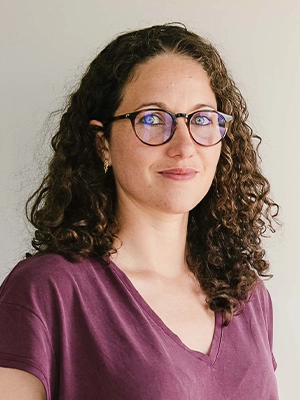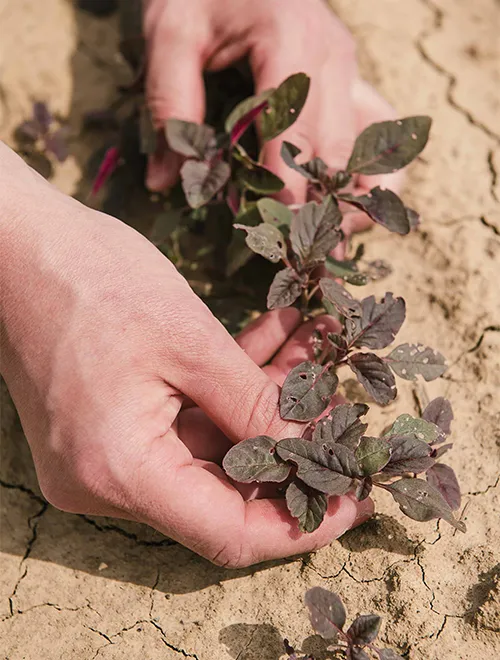At the end of her agricultural studies, Marion Breteau completed a six-month internship, supporting projects for processing and selling farm products. When her partner Damien, whom she met in engineering school, took over his family farm in 2015, they had a lightbulb moment and decided to sell their produce through short local supply chains. “We saw the concept as a whole channel, with the idea of managing the processing and marketing part ourselves,” says Marion. However, beyond the desire for autonomy, it was also about helping to build a resilient cultivation model, with crops that are more resistant to adverse weather and requiring fewer inputs. “This model promised to offer better value,” Marion remarks.

The extension of the crop rotation gives us security, particularly with regard to climate hazards, but it also allows us to fight naturally against weeds.
Damien Sneessens
In search of a niche, the couple decided to go for quinoa. After a trip to Peru to study the cultivation system, they sowed a few trial hectares. Quinoa is a spring crop with very small seeds. It resists water stress well but requires careful planting and does not have conventionally approved herbicides. “We have therefore put in a lot of work into mechanical weeding,” says Marion. “After sowing, precision hoeing (by camera) is the other very important step in growing the crop, on row spacing of 45cm. We start quite early, and we can do up to three weeding passes.” Otherwise, the crop requires little in terms of inputs, particularly fertiliser.
Quinoa
Quinoa tolerates water stress well but remains sensitive to heat stress during key developmental stages. The plant requires little input, especially little fertilizer. In terms of plant diseases, it is particularly susceptible to downy mildew.
Processing from A to Z
In parallel to their trials, Marion and Damien began to study the processing process. The goal was to step by step finance it and gradually take over the full process on their farm. This included taking in contract farmers’ crops at harvest, storing them in silos, a sorting line, huller, bagger, etc. “At the start, almost everything was subcontracted,” remembers Marion. “As the volumes grew, we invested. Everything is now done on site.”
While this processing chain was getting under way, the couple were also looking for ways to market their farm products in short local supply channels. An initial brand, “Sa majesté la graine” (‘His majesty the seed’), was launched in 2018 for conventional quinoa, sold first in markets and in farm shops. However, they needed to diversify their customer base. “We just went for it,” recalls Marion. “We visited a lot of trade shows, particularly food trade shows (SIAL, and SIRHA in Lyon). We went to further proccessor stands saying: ‘We are going to produce these seeds, are you interested, and in what volumes?’ In this way, we managed to put in place multi-year contracts.”
Two brands created
Today, they have diversified their crops on the family farm, which comprises 270ha, of which 100ha are farmed organically. The crops grown now include durum wheat, barley, einkorn, quinoa, various legumes, and, depending on the year, sunflowers, amaranth, triticale, and buckwheat as a catch crop. The farm has HVE (high environmental value) certification and has created a second organic brand, ‘Graines de sens’ (‘Seeds of meaning’). The couple now also buy from 50 farmers under contract, to safeguard volumes. Forty percent of the products go through “Berry Graines”, the company created for short local supply chains. The rest goes through a farm co-operative and traders.
The farm sells to a wide variety of businesses. “This is important to achieve our sales objectives,” says Marion. “Some take a large volume of one product from us, but in future will potentially have a need for another seed that we already produce. On the other end of the scale, we have other customers who take the whole range from us.”
Demanding communication
When Marion and Damien started, they knew nothing about marketing and communications. The beginnings involved some trial and error. After filing the original trademark with Inpi, the French National Institute of Industrial Property, a letter from a lawyer arrived two months later. “A co-operative in Normandy had a name that resembled ours and they asked us to withdraw it,” recalls Marion, who recommends consulting a lawyer when starting out, to minimise risks. The lawyer will review the existing brands and confirm the validity of the name. “One of the pieces of advice he gave us, even if we didn’t necessarily follow it, was that if you want to be sure not to have any trouble, find a name that has nothing to do with the product.”

We are seeking to build a resilient cultivation model, with crops that are more resistant to adverse weather and require fewer inputs.
Marion Breteau
Once the brand is launched, you then need to manage its image. “We have several websites that need to be maintained, not to mention Facebook, Instagram and Linkedin,” says Marion, who has become more professional at marketing, through several training courses. Texts, photos or videos are devoted to both the products and the field work throughout the season. “It involves a lot of monitoring. You have to respond to comments and publish content regularly, always trying to keep the same tone and key messages. The advantage is that we now have access to a host of statistical tools to better guide our posts.”
“Suffice to say that the time taken up by communication should not be underestimated”, warns Marion, who devotes more than two hours a day to it, while remaining involved in the farm’s processing activities as well. “Even if my partner sometimes teases me by saying that I’m off to have fun on Instagram again,” she says with a smile, “it’s real work that is essential from a business point of view. We have won several contracts via social networks, and as soon as we meet consumers, they tell us ‘we saw that on social media’.”


Synergy between crops and livestock
The farm maintains 75 suckler cows (Salers and Limousins) on its 80ha of grass, in fields unsuitable for arable crops. These breeds consume little in winter, and concentrates are fully covered by waste from the sorting line. “We also collect the manure, which is very useful for us (adding nutrients and organic matter to the soil). We make our own hay and straw and are thinking about incorporating meadows into the crop rotations.” The meat is sold as carcasses – there is no question of getting involved in local short supply chains here. “When I see the regulations and the constraints to which we are subject while producing dry products, I take my hat off to those who produce fresh food,” says Marion.
Strong believers in crop-livestock synergy, this agronomic engineering couple make no apologies for communicating about the interest of plant proteins for their farm brands. “We are not targeting the vegetarian or vegan public at all,” Marion notes. “But while we remain producers, we like to point out the fact that it is interesting, from time to time, to replace animal proteins with plants, particularly for nutritional reasons.”
Going your own way
Marion Breteau and Damien Sneessens dared to go their own way: They founded the brand “Sa Majesté la Graine”. This means they have short marketing chains and a more resilient operating system with more added value.
Restore meaning
So what are the strengths and constraints of such a system? “There are a lot of new skills to learn. It’s not something that everyone will find rewarding,” insists Marion, a former short supply chain adviser. For example, human resources management, with the 11 Berry Graines employees, takes up 30% of her working timee. “The problem with having your own brand is that if there is an issue, we are directly responsible. We cannot blame anyone else since there are no more intermediaries. We must therefore be irreproachable in terms of quality.” This also means keeping an objective view with regard to questions of scale. “The risk is in developing the business too quickly, because very often, there is a considerable demand increase as a result.”
The couple’s growing reputation brings them advantages. “It helps us get openings with new customers,” acknowledges Marion. Relations with banks and insurance companies are now stronger after what was a difficult start, due to the unusual nature of the project. Finally, the job is not all about volume or image. “It’s very rewarding thanks to the contact we get with customers and consumers. We are no longer just industry suppliers,” she explains. “Our contract growers are always happy, when they go shopping at the supermarket, to see the seed packets with their own products inside. It makes them proud. They get packets from us and they give them to friends and family. It gives more meaning to the farming profession, and this notion is very important to us.”







